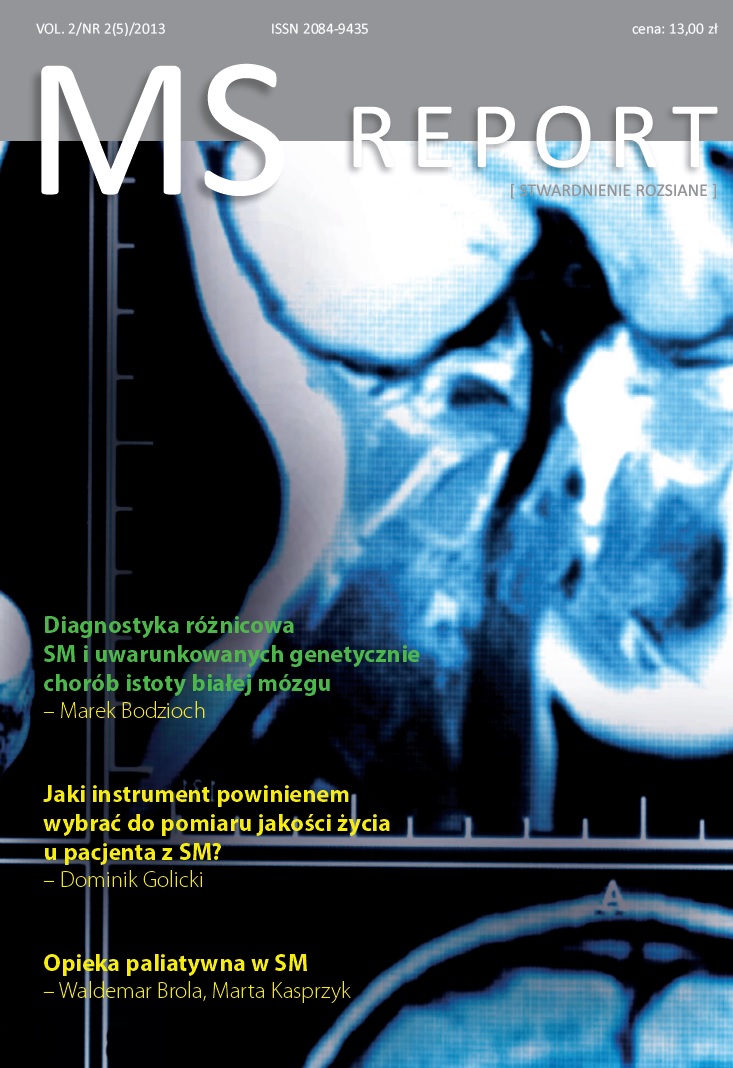Diagnostyka różnicowa stwardnienia rozsianego i uwarunkowanych genetycznie chorób istoty białej mózgu Artykuł przeglądowy
##plugins.themes.bootstrap3.article.main##
Abstrakt
Uwarunkowane genetycznie choroby istoty białej mózgu są ważnym, ale niedocenianym składnikiem diagnostyki różnicowej stwardnienia rozsianego. Prawdopodobnie występują one znacznie częściej, niż się powszechnie przypuszcza, ale często pozostają nierozpoznane, a w wielu przypadkach mogą być błędnie uznawane za stwardnienie rozsiane. Prawidłowe rozpoznanie choroby genetycznej ma istotne znaczenie dla ustalenia rokowania, postępowania profilaktycznego i leczniczego (w niektórych przypadkach także leczenia przyczynowego), poradnictwa genetycznego oraz określenia stanu nosicielstwa u innych członków rodziny. Skuteczną identyfikację chorych obarczonych zwiększonym ryzykiem przyczyny genetycznej mogą ułatwić przedstawione w tym artykule cztery filary diagnostyki różnicowej obejmujące: wywiad rodzinny, wyniki neuroobrazowania metodą rezonansu magnetycznego, przebieg kliniczny oraz współistniejące objawy. Stwierdzenie cech charakterystycznych dla zespołu genetycznego (a mniej typowych dla stwardnienia rozsianego) w zakresie któregokolwiek z tych czterech filarów uzasadnia podjęcie dalszej szczegółowej diagnostyki w poszukiwaniu swoistego defektu genetycznego.
##plugins.themes.bootstrap3.article.details##
Copyright © by Medical Education. All rights reserved.
Bibliografia
2. Bonkowsky J.L., Nelson C., Kingston J.L. et al.: The burden of inherited leukodystrophies in children. Neurology 2010; 75: 718-25.
3. Fluharty A.L.: Arylsulfatase A. Deficiency. W: GeneReviews™. Pagon R.A., Bird T.D., Dolan C.R., Stephens K., Adam M.P. (red.). University of Washington, Seattle 1993–2013.
4. Steinberg S.J., Moser A.B., Raymond G.V.: X-Linked Adrenoleukodystrophy. W: GeneReviews™. Pagon R.A., Bird T.D., Dolan C.R., Stephens K., Adam M.P. (red.). University of Washington, Seattle 1993–201.
5. Adib-Samii P., Brice G., Martin R.J., Markus H.S.: Clinical spectrum of CADASIL and the effect of cardiovascular risk factors on phenotype: study in 200 consecutively recruited individuals. Stroke 2010; 41: 630-4.
6. Potemkowski A.: Analiza epidemiologiczna stwardnienia rozsianego w województwie szczecińskim: ocena zachorowalności i chorobowości w latach 1993–1995. Neurol. Neurochir. Pol. 1999; 33: 34-44.
7. Ługowska A., Ponińska J., Krajewski P. et al.: Population carrier rates of pathogenic ARSA gene mutations: is metachromatic leukodystrophy underdiagnosed? PLoS One 2011; 6: e20218.
8. Sadovnick A.D., Dircks A., Ebers G.C.: Genetic counselling in multiple sclerosis: risks to sibs and children of affected individuals. Clin. Genet. 1999; 56: 118-22.
9. Mahmood A., Dubey P., Moser H.W., Moser A.: X-linked adrenoleukodystrophy: therapeutic approaches to distinct phenotypes. Pediatr. Transplant. 2005; 7(suppl): 55-62.
10. Prust M., Wang J., Morizono H. et al.: GFAP mutations, age at onset, and clinical subtypes in Alexander disease. Neurology 2011; 77: 1287-94.
11. Kanekar S., Gustas C.: Metabolic Disorders of the Brain: Part I. Semin. Ultrasound CT MRI 2011; 32: 590-614.
12. Kanekar S., Verbrugge J.: Metabolic Disorders of the Brain: Part II. Semin. Ultrasound CT MRI 2011; 32: 615-636.
13. van der Knaap M.S., Pronk J.C., Scheper G.C.: Vanishing white matter disease. Lancet Neurol. 2006; 5: 413-23.
14. Nandhagopal R., Krishnamoorthy S.G.: Neurological picture. Tigroid and leopard skin pattern of dysmyelination in metachromatic leucodystrophy. J. Neurol. Neurosurg. Psychiatry 2006; 77: 344.
15. Namekawa M., Takiyama Y., Honda J. et al.: Adult-onset Alexander disease with typical „tadpole” brainstem atrophy and unusual bilateral basal ganglia involvement: a case report and review of the literature. BMC Neurol. 2010; 10: 21.
16. Eichler F., Mahmood A., Loes D. et al.: Magnetic Resonance Imaging Detection of Lesion Progression in Adult Patients With X-linked Adrenoleukodystrophy. Arch. Neurol. 2007; 64: 659-664.
17. O’Sullivan M., Jarosz J.M., Martin R.J., Deasy N., Powell J.F., Markus H.S.: MRI hyperintensities of the temporal lobe and external capsule in patients with CADASIL. Neurology 2001; 56: 628-34.
18. Rolfs A., Bottcher T., Zschiesche M., Morris P., Winchester B., Bauer P., Walter U., Mix E., Lohr M., Harzer K., Strauss U., Pahnke J., Grossmann A., Benecke R.: Prevalence of Fabry disease in patients with cryptogenic stroke: a prospective study. Lancet 2005; 366: 1794-6.
19. Küker W., Weir A., Quaghebeur G., Palace J.: White matter changes in Leber’s hereditary optic neuropathy: MRI findings. Eur. J. Neurol. 2007; 14: 591-3.
20. Palace J.: Multiple sclerosis associated with Leber’s Hereditary Optic Neuropathy. J. Neurol. Sci. 2009; 286: 24-7.
21. Nikoskelainen E.K.: Clinical picture of LHON. Clin. Neurosci. 1994; 2: 115-20.
22. Jangouk P., Zackowski K.M., Naidu S., Raymond G.V.: Adrenoleukodystrophy in female heterozygotes: underrecognized and undertreated. Mol. Genet. Metab. 2012; 105: 180-5.
23. Razvi S.S., Bone I.: Single gene disorders causing ischaemic stroke. J. Neurol. 2006; 253: 685-700.
24. Yatsuga S., Povalko N., Nishioka J. et al.: MELAS: a nationwide prospective cohort study of 96 patients in Japan. Biochim. Biophys. Acta 2012; 1820: 619-24.
25. Ghezzi A., Deplano V., Faroni J. et al.: Multiple sclerosis in childhood: clinical features of 149 cases. Mult. Scler. 1997; 3: 43-6.
26. Mehta A.B.: Anderson-Fabry disease: developments in diagnosis and treatment. Int. J. Clin. Pharmacol. Ther. 2009; 1(suppl): S66-74.
27. Pisani A., Visciano B., Roux G.D. et al.: Enzyme replacement therapy in patients with Fabry disease: state of the art and review of the literature. Mol. Genet. Metab. 2012; 107: 267-75.
28. Garavelli L., Rosato S., Mele A. et al.: Massive hemobilia and papillomatosis of the gallbladder in metachromatic leukodystrophy: a life-threatening condition. Neuropediatrics 2009; 40: 284-6.
29. Ghezzi L., Scarpini E., Rango M. et al.: A 66-year-old patient with vanishing white matter disease due to the p.Ala87Val EIF2B3 mutation. Neurology 2012; 79: 2077-8.
30. Anderson P.J., Leuzzi V.: White matter pathology in phenylketonuria. Mol. Genet. Metab. 2010; 1(suppl): S3-9.
31. Apartis E., Blancher A., Meissner W.G. et al.: FXTAS: new insights and the need for revised diagnostic criteria. Neurology 2012; 79: 1898-907.
32. Taylor R.A., Simon E.M., Marks H.G., Scherer S.S.: The CNS phenotype of X-linked Charcot-Marie-Tooth disease: more than a peripheral problem. Neurology 2003; 61: 1475-8.

